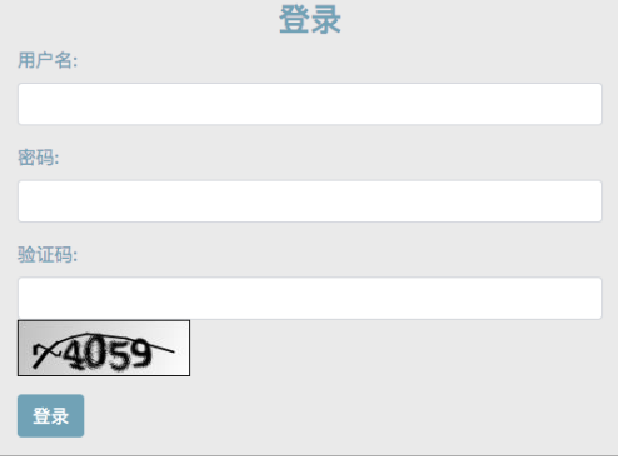添加登录验证码
登录验证码也是项目中一个常见的需求,但是 Spring Security 对此并未提供自动化配置方案,需要开发者自行定义。一般来说,有两种实现登录验证码的思路:
-
自定义过滤器。
-
自定义认证逻辑。
通过自定义过滤器来实现登录验证码,这种方案我们会在本书后面的过滤器章节中介绍,这里先来看如何通过自定义认证逻辑实现添加登录验证码功能。
生成验证码,可以自定义一个生成工具类,也可以使用一些现成的开源库来实现。这里采用开源库 kaptcha,首先引入 kaptcha 依赖,代码如下:
<dependency>
<groupId>com.github.penggle</groupId>
<artifactId>kaptcha</artifactId>
<version>2.3.2</version>
</dependency>然后对 kaptcha 进行配置:
@Configuration
public class KaptchaConfig {
@Bean
Producer kaptcha() {
Properties properties = new Properties();
properties.setProperty("kaptcha.image.width", "150");
properties.setProperty("kaptcha.image.height", "50");
properties.setProperty("kaptcha.textproducer.char.string", "0123456789");
properties.setProperty("kaptcha.textproducer.char.length", "4");
Config config = new Config(properties);
DefaultKaptcha defaultKaptcha = new DefaultKaptcha();
defaultKaptcha.setConfig(config);
return defaultKaptcha;
}
}配置一个 Producer 实例,主要配置一下生成的图片验证码的宽度、长度、生成字符、验证码的长度等信息。配置完成后,我们就可以在 Controller 中定义一个验证码接口了:
@Autowired
Producer producer;
@GetMapping("/vc.jpg")
public void getVerifyCode(HttpServletResponse resp, HttpSession session)
throws IOException {
resp.setContentType("image/jpeg");
String text = producer.createText();
session.setAttribute("kaptcha", text);
BufferedImage image = producer.createImage(text);
try (ServletOutputStream out = resp.getOutputStream()) {
ImageIO.write(image, "jpg", out);
}
}在这个验证码接口中,我们主要做了两件事:
-
生成验证码文本,并将文本存入 HttpSession 中。
-
根据验证码文本生成验证码图片,并通过 IO 流写出到前端。
接下来修改登录表单,加入验证码,代码如下:
<form id="login-form" class="form" action="/doLogin" method="post">
<h3 class="text-center text-info">登录</h3>
<div th:text="${SPRING_SECURITY_LAST_EXCEPTION}"></div>
<div class="form-group">
<label for="username" class="text-info">用户名:</label><br>
<input type="text" name="uname" id="username" class="form-control">
</div>
<div class="form-group">
<label for="password" class="text-info">密码:</label><br>
<input type="text" name="passwd" id="password" class="form-control">
</div>
<div class="form-group">
<label for="kaptcha" class="text-info">验证码:</label><br>
<input type="text" name="kaptcha" id="kaptcha" class="form-control">
<img src="/vc.jpg" alt="">
</div>
<div class="form-group">
<input type="submit" name="submit" class="btn btn-info btn-md"
value="登录">
</div>
</form>在登录表单中增加一个验证码输入框,验证码的图片地址就是我们在 Controller 中定义的验证码接口地址。
接下来就是验证码的校验了。经过前面的介绍,读者已经了解到,身份认证实际上就是在 AuthenticationProvider#authenticate 方法中完成的。所以,验证码的校验,我们可以在该方法执行之前进行,需要配置如下类:
public class KaptchaAuthenticationProvider extends DaoAuthenticationProvider {
@Override
public Authentication authenticate(Authentication authentication)
throws AuthenticationException {
HttpServletRequest req = ((ServletRequestAttributes) RequestContextHolder
.getRequestAttributes()).getRequest();
String kaptcha = req.getParameter("kaptcha");
String sessionKaptcha =
(String) req.getSession().getAttribute("kaptcha");
if (kaptcha != null && sessionKaptcha != null
&& kaptcha.equalsIgnoreCase(sessionKaptcha)) {
return super.authenticate(authentication);
}
throw new AuthenticationServiceException("验证码输入错误");
}
}这里重写 authenticate 方法,在 authenticate 方法中,从 RequestContextHolder 中获取当前请求,进而获取到验证码参数和存储在 HttpSession 中的验证码文本进行比较,比较通过则继续执行父类的 authenticate 方法,比较不通过,就抛出异常。
|
有的读者可能会想到通过重写 DaoAuthenticationProvider 类的 additionalAuthenticationChecks 方法来完成验证码的校验,这个从技术上来说是没有问题的,但是这会让验证码失去存在的意义,因为当 additionalAuthenticationChecks 方法被调用时,数据库查询已经做了,仅仅剩下密码没有校验,此时,通过验证码来拦截恶意登录的功能就已经失效了。 |
最后,在 SecurityConfig 中配置 AuthenticationManager,代码如下:
@Configuration
public class SecurityConfig extends WebSecurityConfigurerAdapter {
@Bean
UserDetailsService us1() {
return new InMemoryUserDetailsManager(User.builder()
.username("javaboy").password("{noop}123").roles("admin").build());
}
@Bean
AuthenticationProvider kaptchaAuthenticationProvider() {
KaptchaAuthenticationProvider provider =
new KaptchaAuthenticationProvider();
provider.setUserDetailsService(us1());
return provider;
}
@Override
@Bean
public AuthenticationManager authenticationManagerBean() throws Exception {
ProviderManager manager =
new ProviderManager(kaptchaAuthenticationProvider());
return manager;
}
@Override
protected void configure(HttpSecurity http) throws Exception {
http.authorizeRequests()
.antMatchers("/vc.jpg").permitAll()
.anyRequest().authenticated()
//省略
}
}这里配置分三步:首先配置 UserDetailsService 提供数据源;然后提供 一个 AuthenticationProvider 实例并配置 UserDetailsService;最后重写 authenticationManagerBean 方法,提供一个自己的 ProviderManager 并使用自定义的 AuthenticationProvider 实例。
另外需要注意,在 configure(HttpSecurity) 方法中给验证码接口配置放行,permitAll 表示这个接口不需要登录就可以访问。
配置完成后,启动项目,浏览器中输入任意地址都会跳转到登录页面,如图 3-5 所示。

此时,输入用户名、密码以及验证码就可以成功登录。如果验证码输入错误,则登录页面会自动展示错误信息。